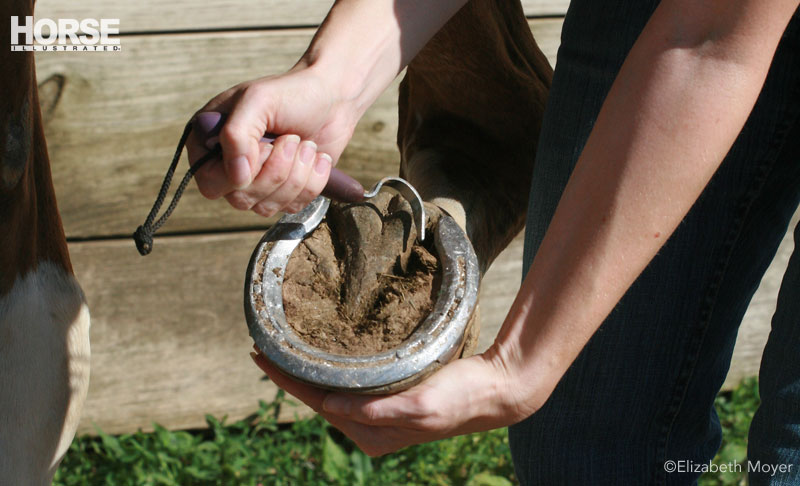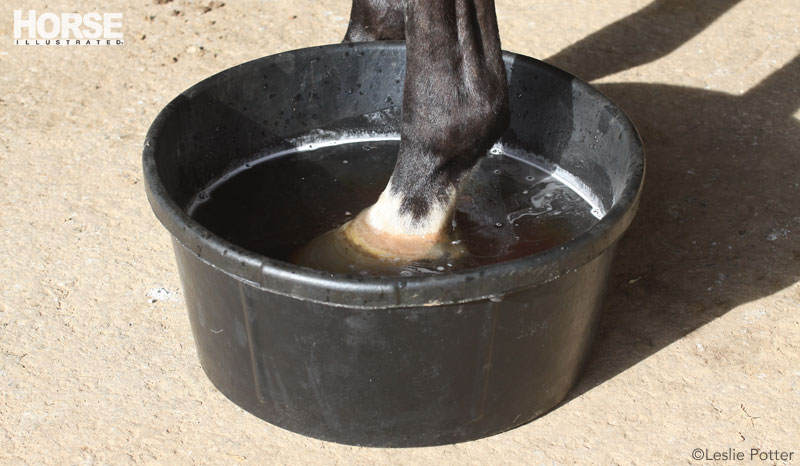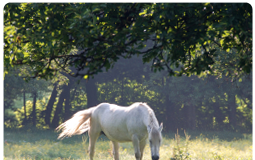Some horses are blessed with good, strong feet. While their owners can thank their lucky stars, others have horses with less-than-stellar hooves and know the problems that can bring.

Diligence
The easiest yet most critical component of your hoof-care tool kit is to pay attention and stay on the ball. Regularly pick out your horse’s feet, checking for any abnormalities such as loose clinches or sprung shoes on shod horses, heat, cracks or thrush. “Be aware, be a good all-around horseman, and be cognizant of different hoof abnormalities,” says Dryden.
Next up is good housekeeping. Avoid exposing your horse to excessively wet, muddy or rocky conditions. “Keep the horse in a good environment,” recommends Dryden. “You can’t expect a horse to thrive in mud, feces and urine, or a rocky field.”
While exposure to rocky terrain can lead to bruising and abscesses, increased bacterial growth from wet and muddy conditions can result in ailments like thrush and white line disease. In addition, wet-dry cycles can cause the hoof to expand and contract, causing cracks and loosening clinches.
Like Clockwork
Quality, regular farriery is paramount to good hooves. “The best thing a horse owner can do is to identify a qualified farrier to regularly trim or shoe their horse’s feet on a four- to six-week shoeing or trimming cycle to maintain a nice, solid foot,” notes Dryden. Farrier care is not a place to pinch pennies. Don’t try to stretch out a shoeing cycle, and don’t settle for the lowest bidder just to save a buck. You will get what you pay for.
|
When looking for a horseshoer, remember that there are no mandatory licensing requirements in the U.S. to practice farriery. Voluntary certification programs, however, attest to a shoer’s knowledge, experience and skill. Look for a professional with credentials from a program such as those offered by the American Farriers Association. Also look for satisfied clients who are willing to serve as references. Word of mouth goes a long way as well: ask for recommendations among your network of equine contacts.
From the Inside Out
If your horse isn’t graced with optimal hooves, you may want to consider a hoof supplement. While proper nutrition always comes first, a quality supplement can be helpful if your horse is still lacking in good, strong hoof growth.
“If a horse is deficient in a trace mineral or an amino acid that is important for developing hooves normally, then supplements may be beneficial,” says Dryden. “I think hoof supplements definitely have a place, and I use them on cases that I feel may not be getting as much nutritional value as they should.” He recommends a supplement containing biotin and methionine, which are thought to bolster hoof resiliency and aid in growth.
Along with supplements, hoof dressings have a place in the hoof-care arsenal. “Topical hoof treatments depend on the environment and the quality of the foot,” explains Dryden. “If the horse has very dry, flaky hooves, it may be best to apply a moisturizing topical. If the horse has extremely soft feet that aren’t holding together well, it may be beneficial to apply a hardening topical, like Keratex, to maintain more rigidity.”
Hot Spots
Even with great care, horses can face their share of hoof ailments. Here are some common issues you might face.
Thrush:
Everyone has experienced the stinky smell of thrushy feet, but did you know that untreated thrush could actually lead to lameness? Thrush is caused by anaerobic bacteria invading the frog tissue from the sulci (grooves alongside the frog), and is characterized by a foul-smelling, black-colored sludge. Daily hoof cleaning can help keep thrush at bay, although other factors may come into play, such as full hoof pads or insufficient exercise, both of which reduce the hoof’s natural ability to shed debris. Upright hoof conformation with deep frog sulci can also predispose a horse to thrush. Store-bought treatments applied according to the manufacturers’ or your veterinarian’s directions can help resolve thrush. However, regular hoof-picking and maintaining a clean environment for your horse are the best methods for preventing this hoof ailment.

Soaking a hoof to treat an abscess.
Abscesses:
One day your horse is sound; the next day he’s extremely lame and may also have a bounding digital pulse in one foot, heat around the coronary band, and swelling up the pastern. This is a well-known scenario that usually indicates a hoof abscess, a relatively common occurrence involving a local infection and pus buildup within the hoof. If your horse is severely lame, call your vet first to discuss the issue; if she thinks it’s an abscess, in many cases it will resolve with treatment you can administer yourself.
Abscesses are often the result of hoof bruising or bacteria invading the hoof via a crack or misplaced nail from a recent shoeing. Luckily, abscess treatment tends to be pretty straightforward, usually involving draining the infected area, soaking, poulticing and hoof wrapping. However, if the abscess does not resolve in a couple of days, it may be necessary to get your veterinarian involved due to the possibility of the infection from the abscess invading a deeper structure, such as the coffin bone.
Chronic, low-grade laminitis:
“Many horse owners don’t even realize that their horses have chronic, low-grade laminitis,” remarks Dryden. These horses are plagued by off-and-on mild lameness and may be older and categorized as metabolic, insulin-resistant, or Cushingoid (having Cushing’s disease). Using lab work and imaging diagnostics, your veterinarian can identify abnormalities and formulate a treatment plan encompassing dietary needs, medical management, exercise, grazing/turnout routine, and therapeutic shoeing options.
White line disease:
Looking at the sole of your horse’s hoof, you can see the junction between the outside hoof wall and the sole, known as the white line. This white-shaded line runs the perimeter of the sole where it meets the hoof wall. Bacteria and fungus that cause white line disease are found everywhere in the environment. These microorganisms are typically anaerobic and consume the white line just inside of the hoof wall. This may lead to separation of the wall, instability of the hoof capsule, and even mechanical laminitis/coffin-bone rotation. Microorganisms typically find their way into the hoof via compromised areas of the white line, such as a weak and cracked hoof wall.
Your veterinarian and farrier will be able to determine the extent of the white line disease and formulate a plan for treatment. Often the diseased area of the hoof must be removed, then treated topically; your veterinarian can recommend products, which can range from a simple chlorine-based solution to commercial products such as White Lightning or CleanTrax. Preventing white line disease is far easier than treating it. Like thrush, white line disease may be circumvented by proper hoof care and good hygiene.
Regardless of whether your horse experiences these hoof problems or one of the many others out there, a skilled vet and farrier team, along with timely intervention, is essential to his well-being.
A little effort goes a long way. “Pick out and care for your horse’s feet daily,” says Dryden. “Take note of patterns and changes. And most importantly, invest in routine farrier care with a qualified individual.” Stay on top of things; you’ll know if your horse’s hoof care is working when he’s sound, even and balanced.
Liked this article? Here are others you’ll enjoy:
Guide to Horse Hoof Problems
8 Hoof Care Myths
NATALIE DeFEE MENDIK is an award-winning freelance writer specializing in equine media. Her personal horsey passions include dressage and vaulting. Visit her online at www.mendikmedia.com.
This article originally appeared in the September 2014 issue of Horse Illustrated magazine. Click here to subscribe!






Great advice. The low grade laminitis is pretty scary.
Better to treat mini issues before they turn into a major one. Good article, once again.
All horses can have healthy hooves as long as the don’t wear shoes and have a proper barefoot trim. Look it up, you’ll be amazed about how much harm shoes cause to horse’s hooves.
Equisan H is what we use for laminitis in our stable most user friendly product out there.
Love when a “barefooter” posts unintelligent unfounded comments!
Being a farrier myself..most of the 450 horses I service are barefoot and are able to do that with ease and no trouble whatsoever. Shoes are only necessary when a hoof cannot handle being barefoot..in cases where hoof quality is already poor, wear exceeds growth due to quality or footing, laminitis or founder, or in an intensive work program.
Shoes do not cause poor hoof health..only bad shoers and trimming can cause shoes to effect hoof health.
A qualified educated farrier places shoes where necesaary to give PROTECTION!
OBVIOUSLY your information is misguided and you have only viewed poor shoeing jobs.
Remove your own human footwear before you preech that all horses and all hooves can go barefoot!
Not all hooves need shoes…but not all hooves can go without! This is fact!
Edit…shoes may be required in certain conformation issues as well..if not achievable through a trim.